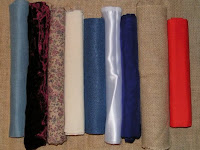| 1. Lock stitch |
| 2. Chain stitch |
| 3. Over lock |
| 4. Flat lock |
| 5. Kansai |
| 6. Bartak |
| 7. Blind stitch |
| 8. Zig-zag |
| 9. Button hole |
| 10. Button attaching |
এই ব্লগটি সন্ধান করুন
রবিবার, ১০ জুলাই, ২০১১
Different types of industrial sewing machine are given below
Different types of industrial sewing machine are given below:
Basic Components of sewing process
Fabric
A textile or cloth is a flexible material consisting of a network of natural or artificial fibers often referred to as thread or yarn. Yarn is produced by spinning raw fibres of wool, flax,cotton, or other material to produce long strands. Textiles are formed by weaving, knitting, crocheting, knotting, or pressing fibres together.
The words fabric and cloth are used in textile assembly trades as synonyms for textile. However, there are subtle differences in these terms in specialized usage. Textile refers to any material made of interlacing fibres. Fabric refers to any material made through weaving, knitting, spreading, crocheting, or bonding that may be used in production of further goods (garments, etc.). Cloth may be used synonymously with fabric but often refers to a finished piece of fabric used for a specific purpose.
Sewing machine including Needle/ needles:
A sewing machine is a textile machine used to stitch fabric, cards and other material together with thread. Sewing machines were invented during the first Industrial Revolution to decrease the amount of manual sewing work performed in clothing companies. the sewing machine has vastly improved the efficiency and productivity of fabric, clothing industries,needle industries.
Modern sewing machines are designed in such a way that the fabric easily glides in and out of the machine without the hassle of needles and thimbles and other such tools used in hand sewing, automating the process of stitching and saving time.
Industrial sewing machines, by contrast, are larger, faster, more complex, and more varied in their size, cost, appearance, and task.
The fabric shifting mechanism may be a workguide or may be pattern-controlled (e.g., jacquard type). Some machines can create embroidery-type stitches. Some have a work holder frame. Some have a workfeeder that can move along a curved path, while others have a workfeeder with a work clamp. Needle guards, safety devices to prevent accidental needle-stickinjuries, are often found on modern sewing machines.
Sewing thread
Swing threads are the main trimming of a garment’s. Sewing thread is directly related to the quality of seam, appearance, loop/ seam strength. Quality of garments depends on sewing thread. But quality of sewing thread depends on types of firers, material used during finishing and methods of sewing thread preparation.
এতে সদস্যতা:
পোস্টগুলি (Atom)












